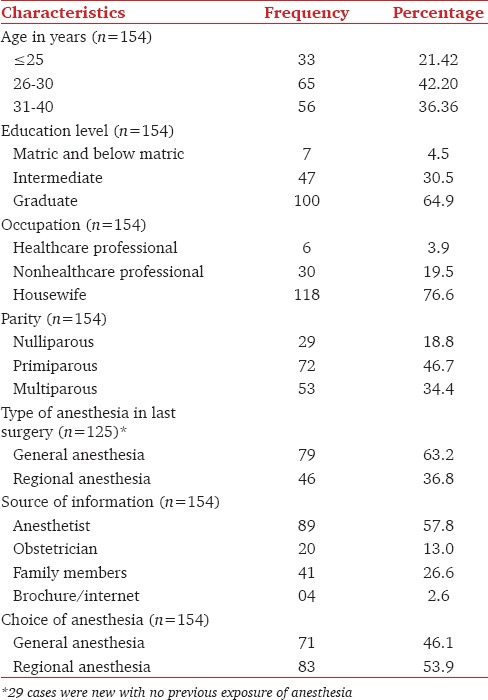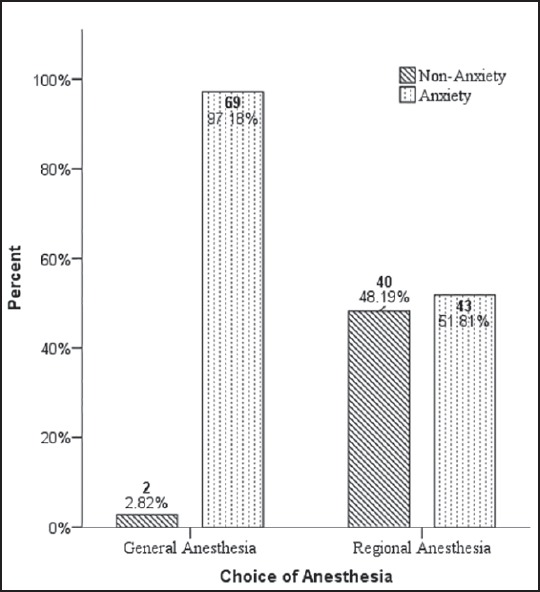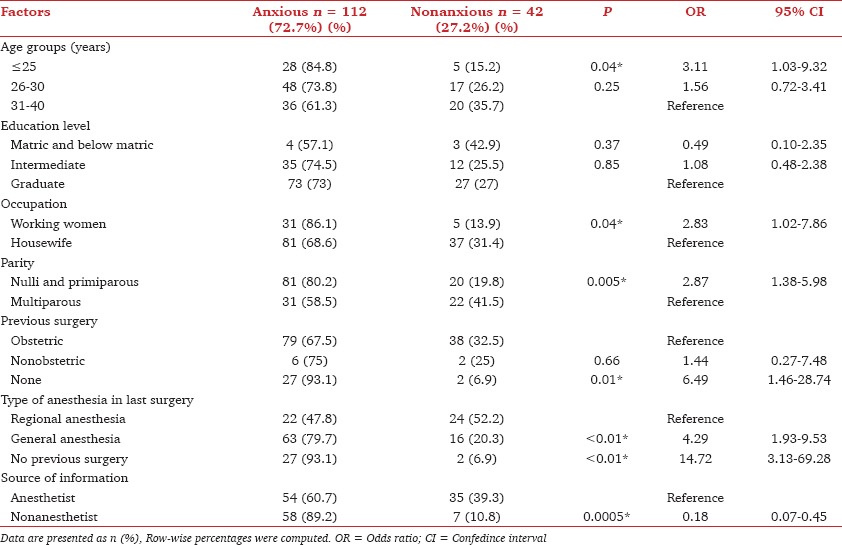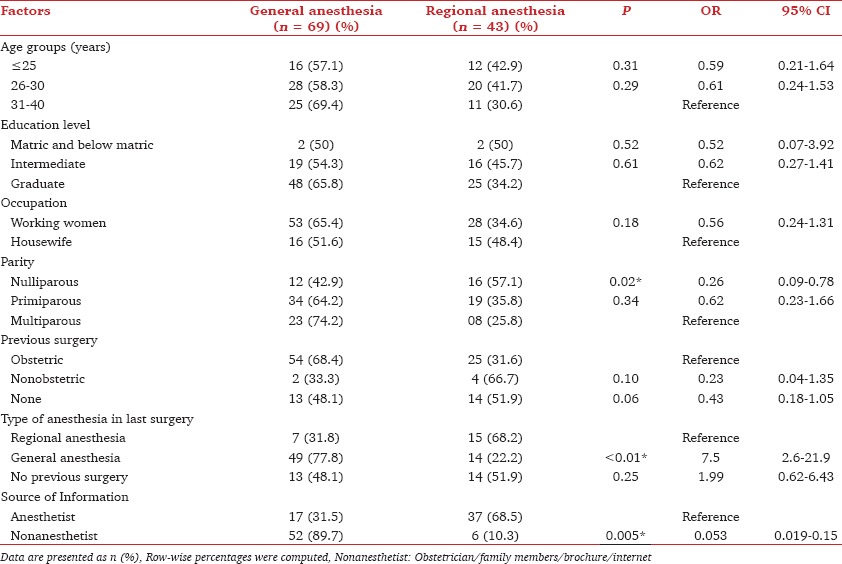Abstract
Background and Aims:
We aimed to measure the frequency of preoperative anxiety in patients undergoing elective cesarean section (CS) and its impact on patients decision regarding the choice of anesthesia.
Material and Methods:
This cross-sectional study included 154 consecutive patients, who were scheduled for elective CS. Visual analog scale (VAS) for anxiety was the study tool, and VAS ≥50 was considered as significant anxiety. Enrolled patients were interviewed by the primary investigator the day before the surgery and their VAS score and choice of anesthesia technique either general anesthesia (GA) or regional anesthesia (RA) were recorded. Additional data included demographics, parity, educational status, previous anesthesia experience and source of information.
Results:
Preoperative anxiety (VAS ≥ 50) was seen in 72.7% of patients, which was significantly higher (P < 0.005) in patients selecting GA (97.18%, n = 71/154) as compared to those selecting RA (51.81%, n = 83/154) for elective CS. Statistically significant association of anxiety (P < 0.005) was seen with age <25 years, nulli and primiparous, higher education status, previous anesthesia experience and source of information from nonanesthetist.
Conclusion:
Patients scheduled for elective CS were found to have high frequency of anxiety (72.7%), and GA was observed to be the choice of anesthesia technique in anxious patients.
Keywords: Anxiety, cesarean section, general anesthesia, regional anesthesia
Introduction
Patients scheduled for surgery experience varying levels of anxiety, due to factors like, cultural diversity, type of surgery, previous anesthesia experience, and preoperative information.[1,2] Previous studies have reported anxiety of being awake during surgery as one of the most common reasons for choosing general anesthesia (GA),[3,4] but whether higher level of preoperative anxiety influences patient's decision to refuse regional anesthesia (RA) needs to be determined.
Literature has reported a higher level of preoperative anxiety in obstetric patients compared to general surgical population.[5,6] Cesarean section (CS) is one of the most common surgical procedures performed on obstetric patients, and RA is the preferred technique of anesthesia in terms of risk and benefits for both mother and fetus. In modern obstetric anesthesia practice, percentage use of RA for CS has become a marker of quality.[7] Unfortunately, in our setup there is still a high rate (46%) of GA in patients undergoing CS and patient's preference is found to be the commonest reason for choosing GA.[8] Therefore, the hypothesis of this study is based on the presumption that a high preoperative anxiety level among parturient scheduled for CS can affect their decisions to prefer GA as the choice of anesthesia technique.
It is essential to determine if anxiety influences the choice of anesthesia among women, in order to take measures to reduce the level of anxiety. This will allow parturients to make a rational decision regarding the choice of anesthesia.[7]
The primary objective of the study was to determine the frequency of anxiety in patients selecting GA or RA for CS. The secondary objective was to determine the factors associated with anxiety in patients selecting either GA or RA.
Material and Methods
After approval from the hospital ethics committee, this cross-sectional study was conducted in obstetric wards from April 01, 2011 to May 31, 2011. Those included in the study were American Society of Anesthesiologists I and II female patients (age between 18 and 45 years) undergoing elective CS who were able to make their own decision for selecting GA or RA. The exclusion criteria included patients not willing to participate in the study, with known psychiatric illness, a history of taking any antianxiety or antidepressant medications, language barrier, having absolute or relative contraindication for either GA or RA, bad obstetric history, complicated pregnancy or having congenital fetal anomaly.
Primary investigator visited the patients one night before the surgery between 18:00 h and 22:00 h. The study participants were detailed about the purpose of the study and were familiarized with visual analog scale for anxiety (VAS scale). A written informed consent was taken prior to the study. Data collection proforma was comprised of two sections, the first section contained the demographic details of the participants and the other section was based on VAS for measuring anxiety by showing a 100 mm straight line, with a zero on the left side indicating no anxiety, and 100 on the right side indicating maximum anxiety. Participants were asked to mark the line below with a vertical stroke to show how anxious they felt at the moment. VAS ≥50 was taken as the presence of anxiety.[9] Patients then were asked about their source of information regarding anesthesia techniques and their choice of anesthesia for scheduled CS.
It was based on the previous study in which anxiety among the obstetric population was reported in the range of 73.3-86%.[3,9] A total of 154 pregnant women were needed to estimate the anticipated rate of anxiety of 73.3% within 7% level of precision with 95% confidence interval. All statistical analysis was performed using Statistical Packages for Social Science version 19 (SPSS Inc., Chicago, IL, USA). Mean and standard deviation were computed for age of the patients. Frequency and percentage were computed for age categories, educational level, occupation, source of information, parity, previous experience of anesthesia, type of anesthesia and anxiety score and analyzed by the Chi-square test. Logistic regression was also applied to compute odd ratio with 95% confidence interval for the association of factors leading to anxiety and choice of anesthesia of the patients and association between various factors and prevalence of anxiety. The P ≤ 0.05 was considered as significant.
Results
During the study period, a total of 157 elective CS were scheduled in our obstetric unit. Out of them 154 patients were enrolled, who consented to be a part of the study and fulfilled the inclusion criteria. The characteristics of the patients’ population in terms of age, education level, occupation, parity, previous anesthesia experience, source of information and choice of anesthesia are presented in Table 1. The majority of the study patients were housewives, with graduate level of education, having previous anesthesia experience and received information from an anesthetist. Overall rate of anxiety was observed in 72.7% (112/154) patients. Rate of anxiety was significantly high in patients of GA group as compared to RA group (97.2% [69/71] vs. 51.8% [43/83]; P < 0.01) as shown in Figure 1.
Table 1.
Patient characteristics in terms of age, education, occupation, parity, previous exposure, source of information and choice of anesthesia

Figure 1.

Comparison of incidence of anxiety between patients with general and regional anesthesia (97.18 vs. 51.81%; P = 0.0005; odds ratio = 32.09 95% confidence interval: 7.37-139.62)
A statistically significant association with preoperative anxiety (VAS ≥ 50) was observed with factors like age <25 years, working women, nulli and primiparous, no previous anesthesia experience, having previous anesthesia experience under GA and those having their source of information from nonanesthestists as presented in Table 2.
Table 2.
Association between various factors and prevalence of anxiety (n=154)

On further analysis, it was found that anxious patients had a statistically significant association (P < 0.05) with factors like nulli and primiparous, having previous anesthesia under GA and getting information from nonanesthetists [Table 3].
Table 3.
Association of factors with choice of anesthesia in anxious patients (n = 112)

Discussion
The study showed an overall high level of anxiety in patients scheduled for elective CS, as 72.2% of the patients had a VAS ≥50, which is consistent with previous studies reporting high level of anxiety in obstetric patients.[5,6] High levels of anxiety in CS patients can possibly be due to the fear of surgery, added to the anxiety of pregnancy. Holmes and Rahe in their social readjustment rating scale have ranked pregnancy 12 out of 43 “Life's most stressful experiences,” while surgery (personal injury or illness) is ranked 6th place in this scale.[10] Therefore, patients undergoing CS, belong to the susceptible group of patients having high level of preoperative anxiety.
This study has shown an association between preoperative anxiety and selection of GA, as high level of anxiety was found in patients selecting GA as compared to those opting for RA (P < 0.05). Previous studies have shown that patients who are unable to cope with the additional challenges of being awake during surgery request GA.[3,11] In addition, fear of regional block not working and needle phobia are additional causes of anxiety preventing patients to choose RA.[12] Consequently, preoperative anxiety due to multiple reasons can affect the patient's choice of anesthesia. Despite RA being the recommended technique for CS, it is contraindicated in cases when there is a patient refusal. In our institution, patient's refusal for RA is one of the major reasons for the failure to achieve the internationally recommended rate of RA for CS.[8,13,14] Other investigators have also cited maternal request as the chief reason for GA especially in elective CS.[15,16]
The average age of patients presenting for CS in our hospital during this study was 29.18 ± 4.46 years, and a correlation was observed between age <25 years with anxiety that is consistent with previous studies.[5,17,18] However, the study conducted by Domar et al., has failed to show age as a determinant of preoperative anxiety.[19] Another factor related to high anxiety in obstetric patients could be female sex as previous studies have reported a high level of anxiety in the female gender.[18,19,20,21] Yet some studies failed to show any correlation of anxiety with female sex.[22,23]
As per the findings, educated patients were more anxious as compared to less educated but the difference was not statistically significant. The literature also shows conformity of high levels of anxiety among educated patients due to their awareness of complications.[5,6,19,21] However, other studies contradict the association between anxiety and education.[18,23]
The study findings and literature state that nulliparous patients tend to have a high level of anxiety.[18,20,21] While, Thorp et al. reported that previous experience does not reduce preoperative anxiety.[24]
A significant association of anxiety was found in patients having previous surgery under GA, who preferred to have GA again. Kindler et al., found higher scores of anxiety in patients with previous negative experience.[18]
In this study, patients receiving information from other than anesthetist were more anxious, and majority of them opted for GA. Studies have shown that the source of information from family/friends and misconceptions related to anesthesia are the top most reasons for patients refusing RA.[12,25] This misinformation could also be the source of anxiety influencing patients’ decision. In contrast patients, receiving information from anesthetist were less anxious, and majority of them selected RA. Previously reported literature has shown that a preoperative visit by an anesthetist alone was almost as effective in reducing anxiety as compared to the combination of the preoperative anesthetic visit and premedication.[26] Ngan Kee et al., concluded that anesthetist do influence the decision of patients and can encourage them for RA.[27]
The study has few limitations for instance the indication for CS was not observed, which could influence the level of anxiety among parturient. However, factors like bad obstetric history, complicated pregnancy and patients having congenital fetal anomaly, were among the exclusion criteria of the study. In addition, the satisfaction score among parturients choosing either GA or RA was not measured, but could have reflected patient's satisfaction in relation to the choice of anesthesia technique.
Conclusion
This study has clearly indicated that anxiety was one of the reason for refusing RA in our patient population, therefore specific measures to reduce anxiety in these patients could help us in achieving the international target for RA in CS patients. It is suggested that every patient coming for elective CS should be assessed for the presence of anxiety in their routine preoperative anesthesia assessment and patients found to have a high level of anxiety should be scheduled for an additional counseling session from an anesthetist. This measure helps to reduce the anxiety level and assists in making a rational decision regarding their choice for anesthesia technique.
Footnotes
Source of Support: Nil
Conflict of Interest: None declared.
References
- 1.Carvalho B, Cohen SE, Lipman SS, Fuller A, Mathusamy AD, Macario A. Patient preferences for anesthesia outcomes associated with cesarean delivery. Anesth Analg. 2005;101:1182–7. doi: 10.1213/01.ane.0000167774.36833.99. [DOI] [PubMed] [Google Scholar]
- 2.Jawaid M, Mushtaq A, Mukhtar S, Khan Z. Preoperative anxiety before elective surgery. Neurosciences (Riyadh) 2007;12:145–8. [PubMed] [Google Scholar]
- 3.Shevde K, Panagopoulos G. A survey of 800 patients’ knowledge, attitudes, and concerns regarding anesthesia. Anesth Analg. 1991;73:190–8. doi: 10.1213/00000539-199108000-00013. [DOI] [PubMed] [Google Scholar]
- 4.Kennedy BW, Thorp JM, Fitch W, Millar K. The theatre environment and the awake patient. J Obstet Gynaecol. 1992;12:407–11. [Google Scholar]
- 5.Jafar MF, Khan FA. Frequency of preoperative anxiety in Pakistani surgical patients. J Pak Med Assoc. 2009;59:359–63. [PubMed] [Google Scholar]
- 6.Beilin Y, Rosenblatt MA, Bodian CA, Lagmay-Aroesty MM, Bernstein HH. Information and concerns about obstetric anesthesia: A survey of 320 obstetric patients. Int J Obstet Anesth. 1996;5:145–51. doi: 10.1016/s0959-289x(96)80021-5. [DOI] [PubMed] [Google Scholar]
- 7.Lack JA. Raising the standard: A compendium of audit recipes. [Last accessed on 2014 Apr];R Coll Anaesth. 2006 3:166–7. Available from: http://www.rcoa.ac.uk/system/files/CSQ-ARB-section8.pdf . [Google Scholar]
- 8.Ismail S, Shafiq F, Malik A. Technique of anaesthesia for different grades of caesarean section: A cross-sectional study. J Pak Med Assoc. 2012;62:363–7. [PubMed] [Google Scholar]
- 9.Vallejo MC, Phelps AL, Shepherd CJ, Kaul B, Mandell GL, Ramanathan S. Nitrous oxide anxiolysis for elective cesarean section. J Clin Anesth. 2005;17:543–8. doi: 10.1016/j.jclinane.2005.01.009. [DOI] [PubMed] [Google Scholar]
- 10.Holmes TH, Rahe RH. The social readjustment rating scale. J Psychosom Res. 1967;11:213–8. doi: 10.1016/0022-3999(67)90010-4. [DOI] [PubMed] [Google Scholar]
- 11.Senel AC, Mergan F. Premedication with midazolam prior to caesarean section has no neonatal adverse effects. Braz J Anesthesiol. 2014;64:16–21. doi: 10.1016/j.bjane.2012.08.005. [DOI] [PubMed] [Google Scholar]
- 12.Jlala HA, Bedforth NM, Hardman JG. Anesthesiologists’ perception of patients’ anxiety under regional anesthesia. Local Reg Anesth. 2010;3:65–71. doi: 10.2147/lra.s11271. [DOI] [PMC free article] [PubMed] [Google Scholar]
- 13.Jenkins JG, Khan MM. Anaesthesia for Caesarean section: A survey in a UK region from 1992 to 2002. Anaesthesia. 2003;58:1114–8. doi: 10.1046/j.1365-2044.2003.03446.x. [DOI] [PubMed] [Google Scholar]
- 14.Halpern SH, Soliman A, Yee J, Angle P, Ioscovich A. Conversion of epidural labour analgesia to anaesthesia for caesarean section: A prospective study of the incidence and determinants of failure. Br J Anaesth. 2009;102:240–3. doi: 10.1093/bja/aen352. [DOI] [PubMed] [Google Scholar]
- 15.Aiman J, Mahmood KT, Hussain R, Naeem R. Comparison of spinal/epidural and general anaesthesia in elective C-section patient's vs doctor's choice. Int J Pharma Sci. 2010;2:98–106. [Google Scholar]
- 16.Kan RK, Lew E, Yeo SW, Thomas E. General anesthesia for cesarean section in a Singapore maternity hospital: A retrospective survey. Int J Obstet Anesth. 2004;13:221–6. doi: 10.1016/j.ijoa.2004.04.007. [DOI] [PubMed] [Google Scholar]
- 17.Ebirim LN, Tobin M. Factors responsible for pre-operative anxiety in elective surgical patients at a University Teaching Hospital: A pilot study. Int J Anesthesiol. 2010;29:1–10. [Google Scholar]
- 18.Kindler CH, Harms C, Amsler F, Ihde-Scholl T, Scheidegger D. The visual analog scale allows effective measurement of preoperative anxiety and detection of patients’ anesthetic concerns. Anesth Analg. 2000;90:706–12. doi: 10.1097/00000539-200003000-00036. [DOI] [PubMed] [Google Scholar]
- 19.Domar AD, Everett LL, Keller MG. Preoperative anxiety: Is it a predictable entity? Anesth Analg. 1989;69:763–7. [PubMed] [Google Scholar]
- 20.Moerman N, van Dam FS, Muller MJ, Oosting H. The Amsterdam Preoperative Anxiety and Information Scale (APAIS) Anesth Analg. 1996;82:445–51. doi: 10.1097/00000539-199603000-00002. [DOI] [PubMed] [Google Scholar]
- 21.Caumo W, Schmidt AP, Schneider CN, Bergmann J, Iwamoto CW, Bandeira D, et al. Risk factors for preoperative anxiety in adults. Acta Anaesthesiol Scand. 2001;45:298–307. doi: 10.1034/j.1399-6576.2001.045003298.x. [DOI] [PubMed] [Google Scholar]
- 22.Boker A, Brownell L, Donen N. The Amsterdam preoperative anxiety and information scale provides a simple and reliable measure of preoperative anxiety. Can J Anaesth. 2002;49:792–8. doi: 10.1007/BF03017410. [DOI] [PubMed] [Google Scholar]
- 23.Uddin I, Abdullah K, Tahir J, Rahila I. Preoperative anxiety in patients admitted for elective surgery in King Saud Hospital Unaizah, Alqassim Kingdom of Saudi Arabia. Pak J Med Sci. 2002;18:306–10. [Google Scholar]
- 24.Thorp JM, Kennedy BW, Millar K, Fitch W. Personality traits as predictors of anxiety prior to caesarean section under regional anaesthesia. Anaesthesia. 1993;48:946–50. doi: 10.1111/j.1365-2044.1993.tb07470.x. [DOI] [PubMed] [Google Scholar]
- 25.Ahmad I, Afshan G. Knowledge and attitudes of Pakistani women towards anaesthesia techniques for caesarean section. J Pak Med Assoc. 2011;61:359–62. [PubMed] [Google Scholar]
- 26.Egbert LD, Battit G, Turndorf H, Beecher HK. The value of the preoperative visit by an anesthetist. A study of doctor-patient rapport. JAMA. 1963;17(185):553–5. doi: 10.1001/jama.1963.03060070021016. [DOI] [PubMed] [Google Scholar]
- 27.Ngan Kee WD, Hung VY, Roach VJ, Lau TK. A survey of factors influencing patients’ choice of anaesthesia for caesarean section. Aust N Z J Obstet Gynaecol. 1997;37:300–3. doi: 10.1111/j.1479-828x.1997.tb02414.x. [DOI] [PubMed] [Google Scholar]


